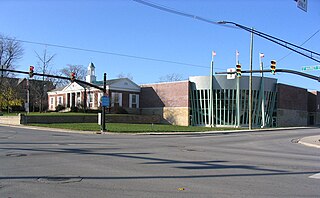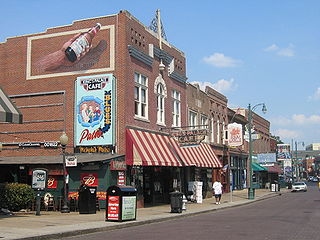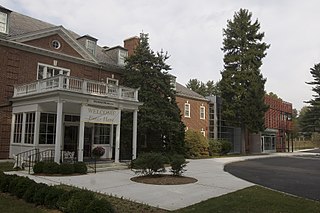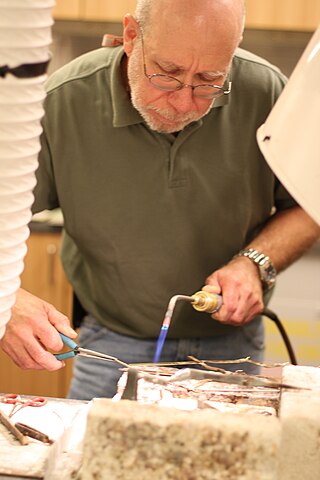
A museum is an institution dedicated to displaying and/or preserving culturally or scientifically significant objects. Many museums have exhibitions of these objects on public display, and some have private collections that are used by researchers and specialists. Compared to a library, a museum hosts a much wider range of objects and usually focus around a specific theme such as the arts, science, natural history, local history, and other topics. Public museums that host exhibitions and interactive demonstrations are often considered to be tourist attractions, and many museums attract large numbers of visitors from outside their host country, with the most visited museums in the world regularly attracting millions of visitors annually.

The Franklin Institute is a science museum and the center of science education and research in Philadelphia, Pennsylvania. It is named after the American scientist and statesman Benjamin Franklin. It houses the Benjamin Franklin National Memorial. Founded in 1824, the Franklin Institute is one of the oldest centers of science education and development in the United States. Its chief astronomer is Derrick Pitts.

The Fashion Institute of Technology (FIT) is a public college in New York City. It is part of the State University of New York and focuses on art, business, design, mass communication, and technology connected to the fashion industry. It was founded in 1944.
The Peel Art Gallery, Museum and Archives (PAMA) is a museum, art gallery, and archives for the Regional Municipality of Peel and are located in Brampton, Ontario, Canada. Previously, it was the Peel Heritage Complex. Its facilities were originally the Peel County Courthouse, Brampton Jail, a land registry office, and a county administration building. It is opposite Gage Park and Brampton City Hall.

The Museum of Science (MoS) is a nature and science museum and indoor zoological establishment located in Science Park, a plot of land in Boston and Cambridge, Massachusetts, spanning the Charles River. Along with over 700 interactive exhibits, the museum features a number of live and interactive presentations throughout the building each day, along with scheduled film showings at the Charles Hayden Planetarium and the Mugar Omni Theater. Additionally, the Museum of Science is an accredited member of the Association of Zoos and Aquariums (AZA), being home to over 100 animals, many of which the museum gained after they were surrendered, confiscated, rescued or rehabilitated.

The Science Museum of Minnesota is an American museum focused on topics in technology, natural history, physical science, and mathematics education. Founded in 1907 and located in Saint Paul, Minnesota, the 501(c)(3) nonprofit institution has 385 employees and is supported by volunteers.

The Quadrangle is the common name for a cluster of museums and cultural institutions in Metro Center, Springfield, Massachusetts, on Chestnut Street between State and Edwards Streets.

The Allen County Museum is located in the city of Lima, the county seat of Allen County, Ohio, United States. Occupying a half city block, the museum campus includes the main museum building, a log house, the MacDonell House, a Shay Locomotive display, the Children's Discovery Center, genealogy and local history library, railroad archives, and the Children's Garden. The museum is accredited by the American Alliance of Museums. According to recent reports of the American Alliance of Museums Accreditation Department, less than 800 museums, out of more than 11,000 in the United States, are accredited. Standards for accreditation apply across the board to both small and large institutions.

The Evansville Museum of Arts, History & Science is a general-interest museum located on the Ohio riverfront in downtown Evansville, Indiana, United States. Founded in 1904, it is one of Southern Indiana's most established and significant cultural institutions, with comprehensive collections in art, history, anthropology and science. It has a permanent collection of over 30,000 objects including fine arts, decorative arts, historic documents and photographs, and anthropologic and natural history artifacts. Also on the museum's campus is the Evansville Museum Transportation Center, featuring Southern Indiana transportation artifacts from the late 19th through the mid-20th centuries. The museum is accredited by the American Alliance of Museums.

The High Desert Museum is located near Bend, Oregon, United States. Opened in 1982, it brings regional wildlife, culture, art and natural resources together to promote an understanding of natural and cultural heritage of North America's high desert country. The museum includes indoor and outdoor exhibits of wildlife in natural-like habitats along with traveling exhibits and living history demonstrations. The museum is accredited by the American Alliance of Museums. It is also a Smithsonian Affiliate institution.

The MIT Museum, founded in 1971, is located at the Massachusetts Institute of Technology in Cambridge, Massachusetts. It hosts collections of holography, technology-related artworks, artificial intelligence, architecture, robotics, maritime history, and the history of MIT. Its holography collection of 1800 pieces is the largest in the world, though only a few selections from it are usually exhibited. As of 2023, works by the kinetic artist Arthur Ganson are the largest long-running displays. There is a regular program of temporary special exhibitions, often on the intersections of art and technology.

The Bruce Museum is a art, science and natural history museum located in Greenwich, Connecticut.

The Indiana State Museum is a museum located in downtown Indianapolis, Indiana, United States. The museum houses exhibits on the science, art, culture, and history of Indiana from prehistoric times to the present day.

Tourism in Memphis includes the points of interest in Memphis, Tennessee such as museums, fine art galleries, and parks, as well as Graceland the Beale Street entertainment district, and sporting events.
Museum Planning is the creation of documents to describe a new museum’s vision, the visitor experience and an organizational plan for a new institution, or one undergoing a major expansion or change in focus.

The New Jersey State Museum is located at 195-205 West State Street in Trenton, in the U.S. state of New Jersey. The museum's collections include natural history specimens, archaeological and ethnographic artifacts, and cultural history and fine art objects. Exhibitions, educational activities, research programs, and lectures are also offered. The museum, a division of the New Jersey Department of State, includes a 140-seat planetarium and a 384-seat auditorium.

Actively running since 1913, the Morris Museum is the second-largest museum in New Jersey at 75,524 square feet (7,016.4 m2). The museum is fully accredited by the American Alliance of Museums.

A mount maker is responsible for the creation of structures called object mounts used to provide unobtrusive physical support, stability, and security of objects while on display, in storage, or being transported to museums, art galleries, libraries, archives, botanical gardens or other cultural institutions. Protection and long-term conservation of the object is a key goal of mount makers. This is accomplished through careful design, selection of materials and manufacturing process that will not inadvertently harm the object, and a cautious installation process of the object into its place in an exhibit. Professionals in this field can be employed directly by an institution, be independent contractors, or work as part of larger cultural institution exhibit design firms.
Hickory Museum of Art (HMA) is an art museum in Hickory, North Carolina which holds exhibitions, events, and public educational programs based on a permanent collection of 19th to 21st century American art. The museum also features a long-term exhibition of Southern contemporary folk art, showcasing the work of self-taught artists from around the region. North Carolina's second-oldest museum, Hickory Museum of Art was established in 1944.

















